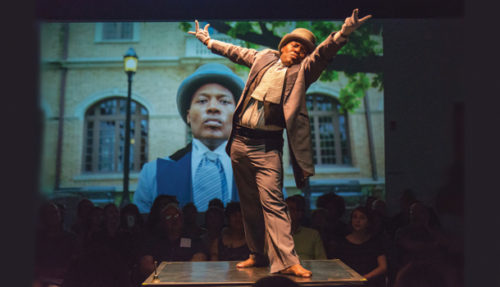SPA Presents the premiere of Harrison Guy’s Colored Carnegie

Photo by Dabphoto Creative
The Society for the Performing Arts presents the premiere of Colored Carnegie by choreographer and cultural trailblazer Harrison Guy on November 12 and 13, 7:30pm, at Jones Hall. Through dance, new music, spoken word, sets, and costumes, Colored Carnegie tells the story of the segregated branch of the Houston Public Library.
With the hire of Meg Booth as CEO of Society for the Performing Arts (SPA), local artists are breathing in a sense of hope as SPA recently approved a strategic plan that recognizes SPA’s responsibility to reflect the Houston community. Guy’s Colored Carnegie is made possible through the SPA Houston Artist Commissioning Project (HACP) which launched in 2020 to promote and sustain Houston’s working artists and artist communities by supporting the creation of new works, including works about underrepresented stories like Colored Carnegie.
SPA received over 60 proposals for the 2020 HACP, and as Booth shares, “Harrison’s project quickly rose to the top. We need to hear more stories. We need more African American stories in the cannon.”
Although it is not his first foray into choreographing African American histories, Guy has been sitting on this idea for close to a decade and knew that this was the time to execute. “We feel very responsible about getting it right,” he explains. Guy created this work for seven dancers from Urban Souls, the dance company he founded in 2004.
The Houston Colored Carnegie Library was a segregated branch of what is now the Houston Public Library. It opened in 1913 in Houston’s Fourth Ward and was one of the first public libraries for African Americans in the southwest. But according to Guy, “the Colored Carnegie story really began in 1907” when Houston’s public library denied service to a group of African American teachers. In 1904 Andrew Carnegie gave a $50,000 grant to the city of Houston for a public library to open on the corner of McKinney and Travis, but only for white citizens. The city offered no comparable library service to Black citizens who made up nearly 40% of Houston. In response, a group led by Black educator E. O. Smith opened a one-room library in the Fourth Ward and then approached the city’s librarian and Mayor to request a separate “colored library” grant from Carnegie. Their application was approved in 1909, and Andrew Carnegie donated $15,000 for the Colored Carnegie Library to open in 1913.
The cast includes eight founding members of the library and one librarian. “I wanted to focus on the key players,” says Guy, “the thing that is tricky about history of Black people, is that it is often not well documented, so you’re going through sketches and people’s memories, and you wind up with contradictory stories. Archiving was not at the forefront.” For Guy, finding primary sources was challenging, but some of the key players like E. O. Smith were so politically active at the time that he could pull information from other historical texts. What he did find out was, “the Color Carnegie story is the same across the United States.”
Houston’s Colored Carnegie did have one big difference. The eight founders decided to launch the library without the involvement of the City of Houston. They wanted an all-Black board of directors for the library, they wanted to raise their own financial support, they wanted to work hand in hand with the architects; they really wanted to do it on their own with the grant from Carnegie.
Guy stumbled on his collaborators in unusual places. He met Kazi Owens, the spoken word artist, at a cooking class. He met composer Dr. John L. Cornelius, II at a Black Choral Concert also nearly a decade ago. He met Bryan Sears, the costumer, at a bar. Guy says, “I have very good gut instincts. I always go with my gut.”
In recent years Guy has broadened his work beyond his company Urban Souls. He makes work as an individual artist and actively advocates for communities within the arts community. Much like the board members in the Colored Carnegie history, he has found this city needs people to step up. He explains, “there was a gap and no one was advocating for the local artists. I couldn’t continue to present full seasons with the company and take on the mantle of arts advocacy. I had to, not because I wanted to, but I knew it needed to be done, so I stepped up.”
This will be Guy’s first time presenting work at Jones Hall. Colored Carnegie has the largest number of collaborators on a single piece for him. “The dancers are moving set pieces. That’s new for me,” he says with excitement. He continues, “The journey getting here has taught me that you can really do whatever you want to do. We don’t need the boxes.” Booth certainly agrees, “Artists will lead. We have the opportunity to create anything.”
The performance of Colored Carnegie shares a bill with South Asian music, Saint Kabir’s Poems in Qawwali by Riyaaz Qawwali, and a new one act play, The World’s Intermission, by former poet laureate of Houston, Deborah D.E.E.P. Mouton.
Tickets can be purchased at spahouston.org.



Recent Comments